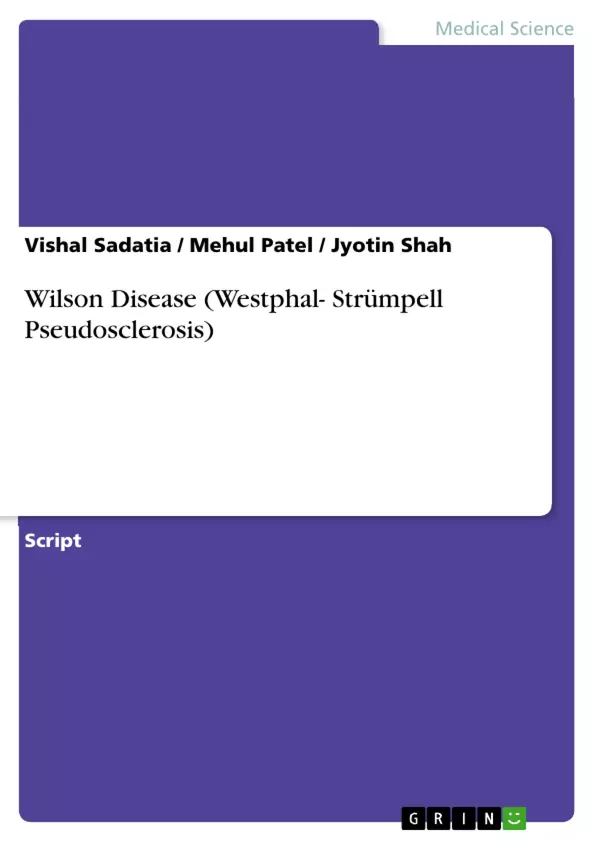The wilson's disease is a disease in which there is a genetic defect in the body for copper metabolism,so that copper is not being utilised in the body and accumulated in the body in various body parts & organs.It will be presented with various clinical presentions like early liver damage & later brain damage.Here i am going to represent 3 cases of the wilson' disease having different type of presentation at early stage.
Inhaltsverzeichnis (Table of Contents)
- ABSTRACT
- KEY WORDS
- INTRODUCTION
- CASE REPORT – 1
- HISTORY
- PAST HISTORY
- EXAMINATION
- GENERAL
- VITALS
- SYSTEMIC
- INVESTIGATIONS
- FUNDOSCOPY
- SLIT LAMP EXAMINATION
- LIVER BIOPSY
- MRI
- TREATMENT
- CASE REPORT - 2
- HISTORY
- PAST HISTORY
- EXAMINATION
- INVESTIGATIONS
- MRI
- TREATMENT
- CASE REPORT - 3
- HISTORY
- PAST HISTORY
- EXAMINATION
- INVESTIGATIONS
- FUNDOSCOPY
- CT SCAN
- TREATMENT
- DISSCUSSION
- REFERENCE
Zielsetzung und Themenschwerpunkte (Objectives and Key Themes)
This case report aims to present three different clinical presentations of Wilson disease, a familial nervous disease associated with Cirrhosis of the Liver. The report highlights the importance of recognizing the diverse manifestations of the disease and emphasizes the role of copper metabolism in its pathogenesis.
- Clinical presentation of Wilson disease
- Copper metabolism and its role in the pathogenesis of Wilson disease
- Diagnosis and treatment of Wilson disease
- Importance of early detection and intervention in Wilson disease
- Challenges in managing Wilson disease based on diverse clinical presentations
Zusammenfassung der Kapitel (Chapter Summaries)
The report details three cases of Wilson disease with distinct clinical presentations. Case Report 1 involves a 30-year-old male presenting with transient episodes of difficulty standing and walking, accompanied by speech difficulties. The patient exhibited involuntary movements and gait abnormality, with normal routine blood investigations but elevated serum copper and urinary copper levels. Kayser-Fleischer rings were present, along with increased copper content in the liver cells. The patient showed gradual improvement with copper chelating therapy. Case Report 2 describes a 34-year-old male presenting with abdominal distention, swelling, breathing difficulties, and left-sided hemiplegia due to a right thalamic infarct. This patient had elevated serum copper and decreased ceruloplasmin levels. Despite treatment with D-Penicillamine, the patient died due to acute liver failure. Case Report 3 concerns a 19-year-old male with abdominal distention, loose motion, vomiting, low-grade fever, and mild jaundice. Investigations revealed elevated bilirubin, SGPT, and serum copper, while ceruloplasmin was decreased. The patient exhibited Kayser-Fleischer rings and mild hydrocephalus on imaging. The patient received treatment with zinc, D-Penicillamine, and supplementary drugs but later succumbed to hepatic encephalopathy.
Schlüsselwörter (Keywords)
Wilson disease, hepatolenticular degeneration, Cirrhosis, Kayser-Fleischer rings, copper metabolism, ceruloplasmin, D-penicillamine, hepatic encephalopathy, neurologic disorder, clinical presentation, diagnosis, treatment.
- Arbeit zitieren
- Dr. Vishal Sadatia (Autor:in), Dr. Mehul Patel (Autor:in), Dr. Jyotin Shah (Autor:in), 2011, Wilson Disease (Westphal- Strümpell Pseudosclerosis), München, GRIN Verlag, https://www.hausarbeiten.de/document/175892


